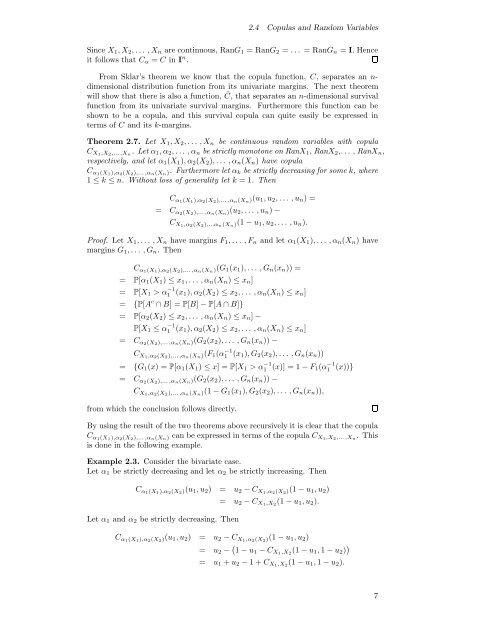Modelling Dependence with Copulas - IFOR
Modelling Dependence with Copulas - IFOR
Modelling Dependence with Copulas - IFOR
Create successful ePaper yourself
Turn your PDF publications into a flip-book with our unique Google optimized e-Paper software.
2.4 <strong>Copulas</strong> and Random Variables<br />
Since X 1 ,X 2 ,... ,X n are continuous, RanG 1 =RanG 2 = ... =RanG n = I. Hence<br />
it follows that C α = C in I n .<br />
From Sklar’s theorem we know that the copula function, C, separates an n-<br />
dimensional distribution function from its univariate margins. The next theorem<br />
will show that there is also a function, Ĉ, that separates an n-dimensional survival<br />
function from its univariate survival margins. Furthermore this function can be<br />
shown to be a copula, and this survival copula can quite easily be expressed in<br />
terms of C and its k-margins.<br />
Theorem 2.7. Let X 1 ,X 2 ,... ,X n be continuous random variables <strong>with</strong> copula<br />
C X1,X 2,... ,X n<br />
.Letα 1 ,α 2 ,... ,α n be strictly monotone on RanX 1 , RanX 2 ,... ,RanX n ,<br />
respectively, and let α 1 (X 1 ),α 2 (X 2 ),... ,α n (X n ) have copula<br />
C α1(X 1),α 2(X 2),... ,α n(X n). Furthermore let α k be strictly decreasing for some k, where<br />
1 ≤ k ≤ n. Without loss of generality let k =1. Then<br />
C α1(X 1),α 2(X 2),... ,α n(X n)(u 1 ,u 2 ,... ,u n )=<br />
= C α2(X 2),... ,α n(X n)(u 2 ,... ,u n ) −<br />
C X1,α 2(X 2),...α n(X n)(1 − u 1 ,u 2 ,... ,u n ).<br />
Proof. Let X 1 ,... ,X n have margins F 1 ,... ,F n and let α 1 (X 1 ),... ,α n (X n )have<br />
margins G 1 ,... ,G n .Then<br />
C α1(X 1),α 2(X 2),... ,α n(X n)(G 1 (x 1 ),... ,G n (x n )) =<br />
= P[α 1 (X 1 ) ≤ x 1 ,... ,α n (X n ) ≤ x n ]<br />
= P[X 1 >α −1<br />
1 (x 1),α 2 (X 2 ) ≤ x 2 ,... ,α n (X n ) ≤ x n ]<br />
= {P[A c ∩ B] =P[B] − P[A ∩ B]}<br />
= P[α 2 (X 2 ) ≤ x 2 ,... ,α n (X n ) ≤ x n ] −<br />
P[X 1 ≤ α −1<br />
1 (x 1),α 2 (X 2 ) ≤ x 2 ,... ,α n (X n ) ≤ x n ]<br />
= C α2(X 2),... ,α n(X n)(G 2 (x 2 ),... ,G n (x n )) −<br />
C X1,α 2(X 2),... ,α n(X n)(F 1 (α −1<br />
1 (x 1),G 2 (x 2 ),... ,G n (x n ))<br />
= {G 1 (x) =P[α 1 (X 1 ) ≤ x] =P[X 1 >α −1<br />
1 (x)] = 1 − F 1(α −1<br />
1 (x))}<br />
= C α2(X 2),... ,α n(X n)(G 2 (x 2 ),... ,G n (x n )) −<br />
C X1,α 2(X 2),... ,α n(X n)(1 − G 1 (x 1 ),G 2 (x 2 ),... ,G n (x n )),<br />
from which the conclusion follows directly.<br />
By using the result of the two theorems above recursively it is clear that the copula<br />
C α1(X 1),α 2(X 2),... ,α n(X n) can be expressed in terms of the copula C X1,X 2,... ,X n<br />
. This<br />
is done in the following example.<br />
Example 2.3. Consider the bivariate case.<br />
Let α 1 be strictly decreasing and let α 2 be strictly increasing. Then<br />
C α1(X 1),α 2(X 2)(u 1 ,u 2 ) = u 2 − C X1,α 2(X 2)(1 − u 1 ,u 2 )<br />
= u 2 − C X1,X 2<br />
(1 − u 1 ,u 2 ).<br />
Let α 1 and α 2 be strictly decreasing. Then<br />
C α1(X 1),α 2(X 2)(u 1 ,u 2 ) = u 2 − C X1,α 2(X 2)(1 − u 1 ,u 2 )<br />
= u 2 − ( 1 − u 1 − C X1,X 2<br />
(1 − u 1 , 1 − u 2 ) )<br />
= u 1 + u 2 − 1+C X1,X 2<br />
(1 − u 1 , 1 − u 2 ).<br />
7
















